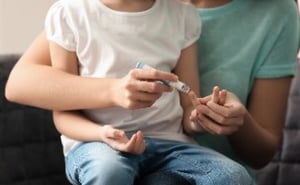Share this
NHS ‘Count on Me’ program helps pediatric transplant patients self-manage blood draws at home
by Neoteryx Microsampling on May 11, 2020 9:30:00 AM
 Close monitoring of patients is essential after a kidney transplant to ensure the body is not rejecting its new organ. Kidney transplant patients typically receive therapeutic drugs post-transplant to help their bodies accept the new organ and remain healthy. These therapeutic drugs require monitoring to make sure the patient is receiving the correct dosage for the greatest benefit without negative side effects or complications.
Close monitoring of patients is essential after a kidney transplant to ensure the body is not rejecting its new organ. Kidney transplant patients typically receive therapeutic drugs post-transplant to help their bodies accept the new organ and remain healthy. These therapeutic drugs require monitoring to make sure the patient is receiving the correct dosage for the greatest benefit without negative side effects or complications.
After getting a kidney transplant, even very young patients must get frequent blood draws for therapeutic drug monitoring (TDM) to check the blood concentration level of the therapeutic drug, tacrolimus.
Why Blood Draws Are Critical and What They Tell Us
The immune system is inclined to attack foreign organisms introduced to the body, and the body interprets a new organ as foreign. Tacrolimus is a therapeutic drug administered orally to prevent rejection by inhibiting, or suppressing, the production of T-lymphocytes immune cells.
The dosage level of this immunosuppressant requires close monitoring to ensure it is within a narrow therapeutic range. Extremely high concentrations lead to toxicity. Low levels can cause organ rejection. Examining blood samples from patients receiving this drug help the healthcare providers adjust the dose to ensure efficacy and avoid toxicity.
Patient monitoring is also essential to keep an eye on creatinine levels in the blood, which indicate if the kidney is being accepted and functioning well. Research shows an effective renal transplant should have creatinine levels of 100-120 uL. Higher levels (for example, 25% more than the average level), are a sign of acute transplant rejection.
Regular monitoring of blood samples is critical to determine appropriate levels of each chemical. This is particularly important in young patients, whose bodies can be more sensitive.
How Blood Collection is Performed
Blood microsampling methods that provide a simple and precise way to collect blood are in high demand, particularly for younger patients who must get frequent blood draws. Techniques that replace venipuncture are becoming more popular, such as a finger-stick blood collection method that can still provide the proper volume of blood needed to determine pharmacokinetic parameters and correct quantities of drug concentrations.
A finger-stick blood draw involves collecting blood from a fingertip on a swab or filter paper. It is then dried and stored. New programs using these simpler and more convenient methods of blood collection have been launched to enable parents of young transplant patients to easily collect blood samples at home. One such program is the CountOnMe® program at Nottingham University Hospital, part of the NHS in the United Kingdom.
The CountOnMe program launched an initiative using Neoteryx® Mitra Microsample Collection Kits from Trajan Scientific and Medical to allow families to collect blood samples at home to assess tacrolimus and creatinine levels. Patients and families received the collection kit from their care providers at the hospital. They used the Mitra® microsampling devices in the kit to perform finger-stick blood sampling at home, and then returned the blood samples by mail for analysis in the lab.
The at-home Microsample Collection Kits provided a convenient and low-stress way of collecting blood samples from young patients in a comfortable, familiar environment.
Remote blood collection options are a very real advantage for children and other vulnerable patients who should avoid the exposure to contagions in facilities, especially during pandemics, such as the COVID-19 outbreak.
How to Use the At-Home Mitra Microsample Collection Kits
Ensure your hands are clean and dry.
- Twist off the tab of the lancet, included in the kit.
- Prick the end of any finger using the lancet.
- If you don't get blood flow, you can massage the finger towards tip.
- Touch the tip of the Mitra samplers in the device to the drop of blood and watch them absorb the blood like a sponge.
- Ensure the sampling tip of the device is positioned over your fingertip, pointing downward to avoid under or over-sampling.
- Write the time and date of the sample taken.
- After all blood samples are collected, close the Mitra device and place it back inside the silver foil specimen bag that it came in.
Return the sample to the lab by placing the sealed specimen bag into the included envelope and drop the envelope in the nearest mailbox.
4 Benefits of Finger-Stick Blood Collection
- Easy to administer – You (or a parent/caregiver) just need to follow the instructions in the kit to collect the sample. You can also follow the sampling videos you find on our website here.
- Less invasive – It’s an excellent method for pediatric blood sampling. It’s less invasive than venous blood draws from the arm, so kids often find it less traumatic.
- Low cost – With finger-stick blood collection, parents don’t have to pull their kids out of school and travel to the clinic or take time off work as often.
- Successful test sample collection – Finger-stick blood collection using the Mitra device has a higher success rate because users can easily make multiple attempts to collect the required amount of blood.


Image Credits: iStock images, Trajan
Share this
- Microsampling (206)
- Research, Remote Research (119)
- Venipuncture Alternative (105)
- Clinical Trials, Clinical Research (83)
- Mitra® Device (73)
- Therapeutic Drug Monitoring, TDM (51)
- Dried Blood Spot, DBS (39)
- Biomonitoring, Health, Wellness (30)
- Infectious Disease, Vaccines, COVID-19 (24)
- Blood Microsampling, Serology (23)
- Omics, Multi-Omics (21)
- Decentralized Clinical Trial (DCT) (20)
- Specimen Collection (18)
- Toxicology, Doping, Drug/Alcohol Monitoring, PEth (17)
- Skin Microsampling, Microbiopsy (14)
- hemaPEN® Device (13)
- Preclinical Research, Animal Studies (12)
- Pharmaceuticals, Drug Development (9)
- Harpera Device (7)
- Industry News, Microsampling News (5)
- Antibodies, MAbs (3)
- Company Press Release, Product Press Release (3)
- Environmental Toxins, Exposures (1)
- July 2025 (1)
- May 2025 (1)
- April 2025 (2)
- December 2024 (2)
- November 2024 (1)
- October 2024 (3)
- September 2024 (1)
- June 2024 (1)
- May 2024 (1)
- April 2024 (4)
- March 2024 (1)
- February 2024 (2)
- January 2024 (4)
- December 2023 (3)
- November 2023 (3)
- October 2023 (3)
- September 2023 (3)
- July 2023 (3)
- June 2023 (2)
- April 2023 (2)
- March 2023 (2)
- February 2023 (2)
- January 2023 (3)
- December 2022 (2)
- November 2022 (3)
- October 2022 (4)
- September 2022 (3)
- August 2022 (5)
- July 2022 (2)
- June 2022 (2)
- May 2022 (4)
- April 2022 (3)
- March 2022 (3)
- February 2022 (4)
- January 2022 (5)
- December 2021 (3)
- November 2021 (5)
- October 2021 (3)
- September 2021 (3)
- August 2021 (4)
- July 2021 (4)
- June 2021 (4)
- May 2021 (4)
- April 2021 (3)
- March 2021 (5)
- February 2021 (4)
- January 2021 (4)
- December 2020 (3)
- November 2020 (5)
- October 2020 (4)
- September 2020 (3)
- August 2020 (3)
- July 2020 (6)
- June 2020 (4)
- May 2020 (4)
- April 2020 (3)
- March 2020 (6)
- February 2020 (3)
- January 2020 (4)
- December 2019 (5)
- November 2019 (4)
- October 2019 (2)
- September 2019 (4)
- August 2019 (4)
- July 2019 (3)
- June 2019 (7)
- May 2019 (6)
- April 2019 (5)
- March 2019 (6)
- February 2019 (5)
- January 2019 (8)
- December 2018 (3)
- November 2018 (4)
- October 2018 (7)
- September 2018 (6)
- August 2018 (5)
- July 2018 (8)
- June 2018 (6)
- May 2018 (5)
- April 2018 (6)
- March 2018 (4)
- February 2018 (6)
- January 2018 (4)
- December 2017 (2)
- November 2017 (3)
- October 2017 (2)
- September 2017 (4)
- August 2017 (2)
- July 2017 (4)
- June 2017 (5)
- May 2017 (6)
- April 2017 (6)
- March 2017 (5)
- February 2017 (4)
- January 2017 (1)
- July 2016 (3)
- May 2016 (1)
- April 2016 (2)

No Comments Yet
Let us know what you think